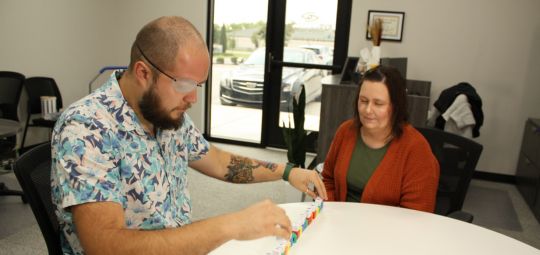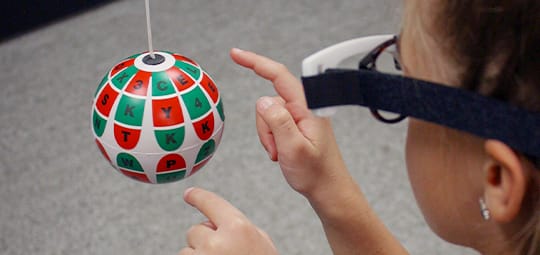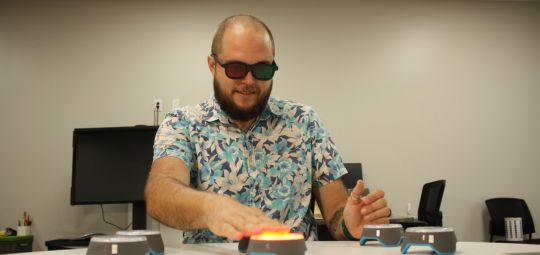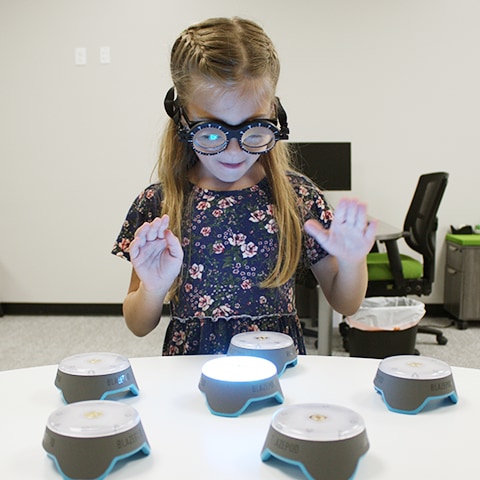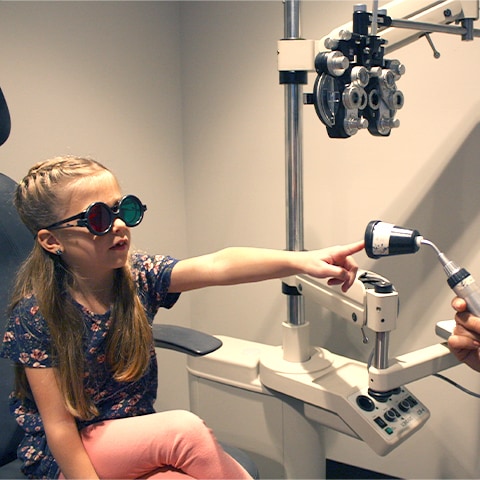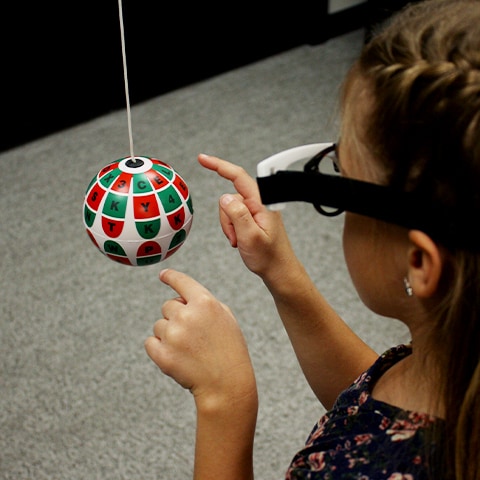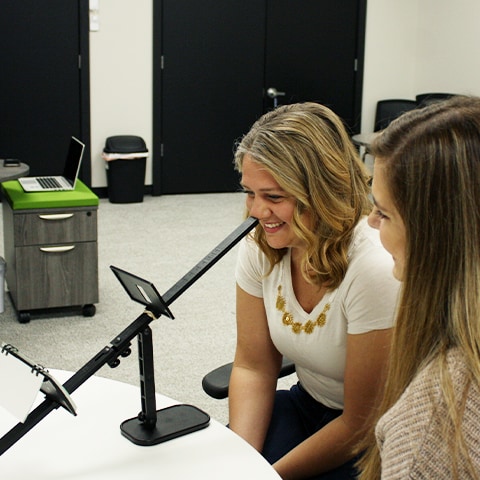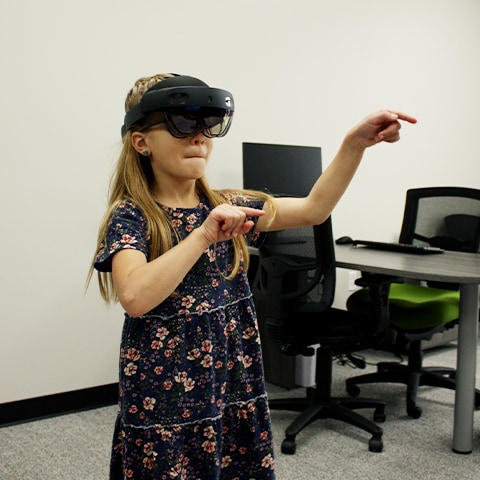Vision Conditions Affect Our Daily Lives
Vision conditions can significantly impact everyday activities. From difficulty concentrating to struggling to follow a moving object, there’s more to healthy vision than clarity.
Vision can affect lifelong development, from social skills to school performance. Vision therapy can help you or your child overcome the challenges of vision conditions so you can preserve your visual health.
Even Small Vision Problems Can Have Big Impacts
Vision conditions can change how you interact with the world. You may avoid pictures because of a visible eye misalignment or skip 3D movies because you wear thick prescription glasses. Double vision or poor spatial awareness can also be a safety issue, whether driving or crossing the street.
We want to support your vision so you can succeed through every stage of life.
Convergence Insufficiency
Convergence insufficiency (CI) occurs when the nerves and muscles controlling eye movements don’t communicate properly. Both eyes need to work together to create comfortable, clear vision.
Symptoms can include:
- Headaches
- Blurred or double vision
- Poor concentration
- Squinting or closing one eye
- Motion sickness or vertigo
A child with CI may have difficulty keeping up in school or frequently lose their place while reading. Learn how we can help support school performance with vision therapy.
What Causes Convergence Insufficiency?
Convergence insufficiency is associated with conditions that affect the brain. The eyes muscles may be physically strong enough, but the messages the brain receives result in poor movement control. The condition can occur because of a lack of development in childhood or health conditions in adulthood.
CI can result because of various risk factors, such as:
- Family history of CI
- Neurodegenerative diseases
- Concussion or brain trauma
- Excessive screen time
Amblyopia
Amblyopia (lazy eye) is the most common cause of vision loss in kids. Fortunately, early treatment can prevent long-term vision problems more effectively.
Having a dominant eye is normal, like being right or left-handed. But when the brain learns to rely on the dominant eye (usually the stronger eye), it can ignore input from the “lazy” or nondominant eye.
Healthy vision requires both eyes teaming together for essential visual skills like depth perception and tracking object movement.
What Causes Amblyopia?
Amblyopia usually develops before age 6. It’s caused by a difference in visual acuity between eyes, such as one eye having a higher degree of nearsightedness (myopia) or farsightedness (hyperopia).
Other common risk factors include:
- Eye turn (strabismus)
- Family history of amblyopia
- Developmental disabilities
- Vision conditions affecting one eye
Regular comprehensive eye exams, including at least once between 6–12 and again between 3–5, can help detect signs or symptoms so your child receives amblyopia care.
Strabismus
Strabismus, also known as crossed eyes, is a condition where one or both eyes don’t align while looking at an object. One eye may look straight ahead while the other eye turns inward, outward, upward, or downward.
Symptoms of strabismus may include double vision, headaches, eye strain, and poor depth perception. Strabismus can be treated through vision therapy, corrective lenses, and, in some cases, surgery. When untreated, strabismus can lead to vision loss.
What Causes Strabismus?
Strabismus typically develops in childhood and results from poor eye muscle control. The condition can be caused by problems with eye muscles or messages from the nerves or brain that direct eye muscle movement.
Risk factors for strabismus include:
- Family history of strabismus
- Severe or uncorrected farsightedness (hyperopia)
- Medical or developmental conditions
Strabismus can worsen without treatment, so it’s crucial to have your child’s eyes assessed if they show signs of eye turn.
What Are Common Signs & Symptoms of Vision Conditions?
Refractive Errors
Refractive errors, including nearsightedness (myopia), farsightedness (hyperopia), and astigmatism (blurry near or far), are common. The condition can be caused by abnormal eye shape or eye tissue.
Signs and symptoms can include:
- Blurred vision
- Frequent eye rubbing
- Squinting
- Headaches
Eye Coordination Problems
Both eyes need to work together to create a complete picture. When the eyes are misaligned, or one eye lacks development, it causes poor quality vision or vision loss.
Amblyopia, strabismus, and convergence insufficiency are examples of eye coordination problems.
Signs and symptoms can include:
- Poor reading comprehension
- Covering or closing one eye
- Frequently rubbing eyes
- Double vision
- Short attention span
Eye Focusing Problems
Accommodative dysfunction is an eye-focusing problem. It’s common in kids and adults whose daily lives have high near-vision demands, like computer work, reading, or crafting.
Signs and symptoms can include:
- Blurred vision when switching between distances
- Headaches or fatigue
- Poor reading comprehension
- Avoiding visually demanding tasks
- Poor productivity or task accuracy
- High distractibility
Visual Perception & Processing Problems
Visual perception is the ability to accurately take in visual information. Processing is the speed at which you can perceive visual information. Traumatic brain injuries, convergence insufficiency, amblyopia, and strabismus can affect perception. Learning disorders, like dyslexia, ADD, and ADHD, can affect processing.
Signs & symptoms can include:
- Poor object, letter, or word recognition
- Difficulty with spatial relations (confusing left & right)
- Trouble learning basic math concepts
- Poor recall of visual material
- Handwriting is crooked or poorly spaced
- Trouble following multi-stepped directions
Let’s Talk About How We Can Help
Vision therapy can help patients of all ages improve their vision quality. Get in touch with the Eye Connect team today.

I loved it here at the eye gallery. It was a blast. Gentry and Dr. Nola made it so much fun. they gave me so much encouragement through the whole thing. When something was hard they would help me and would give me the chance to get it right. When things were easy, they would say ok your results were good! You can move on! Or they would say ok, but let’s do this one more week so we know for you are good. Gentry was so kind and when I was kinda having a bad day, she would make me laugh and smile. I love Gentry and Dr. Nola so much! I will miss them so much! Thank you Gentry and Dr. Nola!!
Abby
Kyler was an average student that came home from school everyday complaining of headaches (this got worse during on-line Covid.) She disliked reading and her comprehension was on the lower side on assessments.
Within a month of vision therapy headaches were less frequent and homework was getting easier. Midway through headaches were gone and grades were improving. By the end she was reading for enjoyment and all grades were improved, even math!
Was it easy? NO! Did it take time out of my schedule to bring her? Yes! Were there tears shed? Yes! Was it hard work? Yes!
Would I do it again? YES!
Mikel
In the summer of 2022 when Dr. Baldwin told me that I needed vision therapy my initial thought was, “this is going to be pointless, I was just born with 80 year old grandma eyes.” My first appointment rolled around and I was able to meet with Dr. Nola about where my vision levels were and where they needed to be. After actually seeing the numbers I saw that I really did need help, and Dr. Nola was ready to teach me. After that I went home with charts, and patches, and glasses that made everything look weird. Little by little I notice that not only was my vision getting better, but my migraines that I had been having for almost a year finally went away! My reading scores/speeds on tests were also improving so much that even my ACT score went up 2 whole points in the span of 3 months! I know that none of this could have been possible without Dr. Nola, Gentry, Parker, Dr. Baldwin, and the rest of the staff at the Eye Gallery. I look forward to seeing them every week and I am so grateful to have them in my life not only as eye doctors, but also as friends that I felt comfortable with and excited to be around. Because of all of these reasons I can say that eye therapy has been one of the best decisions I have made.
Madelyn
Before Vision Therapy I was having a lot of headaches and it was difficult focusing on something far away and then quickly switching my gaze to something close. My therapist was Gentry and she was awesome. She always tried to make the exercises we were doing fun for me and always asked how my week was. Gentry also encouraged me to be consistent in my homework and it really paid off. Now after Vision Therapy I don’t have headaches or struggle doing school!
Claire
The change we have seen in Emily over the last six months has been priceless! She went from being unable to track enough to read and having zero depth perception to reading independently and doing great in her sports. Dr. Nola and Miss Gentry have been amazing in this process and we are so thankful for their care (and patience!). We have seen a change not only in her visual abilities but in her self confidence as well. Finishing this program is a big accomplishment for her and we are so proud!



